Written by: David Waddell | Waddell and Associates
THE BOTTOM LINE:
Animal spirits have dispirited. Confidence levels among consumers, executives, analysts, central bankers, and investors have collapsed. Trump’s tariff tirade has markets on edge, awaiting pessimistic validation on April 2nd. They may be right. If Trump lays out a strategy to fix the deficit with tariffs, markets will fall further. If Trump lays out a strategy for the re-industrialization of America, markets will fall further. However, if Trump lays out a strategy for bullying trading partners into reducing tariffs on us, markets could fly. It’s unclear what will happen on Wednesday, but there is an increasing chance that Trump’s “Liberation Day” could liberate… the Bulls!
Earlier this year, we shared our 2025 Outlook presentation entitled, “That’s the Spirit! How the Revival of Animal Spirits will Impact Economies and Markets in 2025.” We defined Animal Spirits as the instinctive, emotional, and psychological factors that influence economic activity beyond rational decision-making. High Animal Spirits result in risk-seeking behavior, while low Animal Spirits result in risk-avoidant behavior. Typically, when Animal Spirits run hot, future market returns tend to cool as reality undershoots lofty expectations. This informed our forecast for lukewarm stock market performance this year. But just as high expectations present a problem, low expectations present an opportunity. At the moment, animal spirits and expectations have collapsed as Trump’s tariff threats have surged. The following pictures say 1,000 words. I promise I’ll only say 600 to make sense of them.
“Tariffied” Consumers
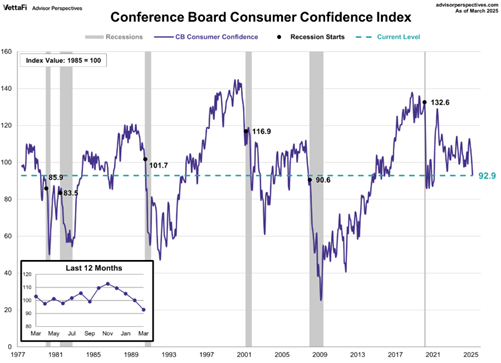
March consumer confidence dropped to the lowest level since January of 2021. Feelings about current conditions weren’t so bad, but feelings about future conditions were terrible!

Source: https://www.conference-board.org/topics/consumer-confidence
As future economic expectations collapsed, so have future stock market return expectations. In fact, the percentage of investors who expect the S&P 500 to rise over the next 12 months fell from nearly 60% at year-end to 37% today. That’s the largest decline in investor expectations over two months EVER!
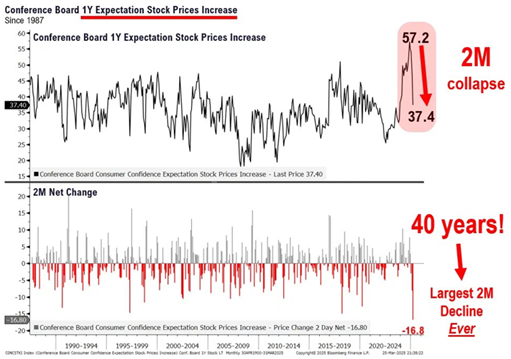
“Tariffied” Executives
And it’s not just consumers feeling “tariffied”, it’s business leaders as well. CEOs tasked with making strategic decisions within a chaotic policy environment have lost faith at an historic rate:
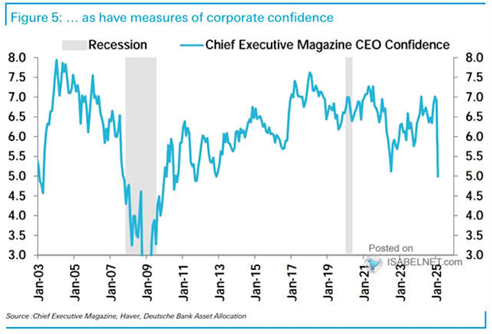
CEO confidence levels haven’t fallen this low since shortly after the Great Financial Crisis, with the current readings the lowest since COVID. In November, 65% of CEO’s expected business conditions to improve over the coming year, compared with just 39% today. As one respondent commented within the survey:
“Deeply concerned about the impact of tariffs and other disruptions to traditional global supply chains and trade alliances,” said one CEO who says his organization is now less bullish on growth initiatives and more on preventing the downside impact of the new trade policies.
“Tariffied” Economists
Coming into the year, none of the major economic forecasting firms called for a recession. Economists expected that the combination of historic household net worths, historic household incomes, historic corporate net worths, and historic corporate profits would support consumer spending, continued payroll additions, and productivity enhancing capital expenditures. The initiation of tariff tirades, and Trump’s willingness to withstand economic weakness as the economy “transitions,” have greatly increased potential recession odds:
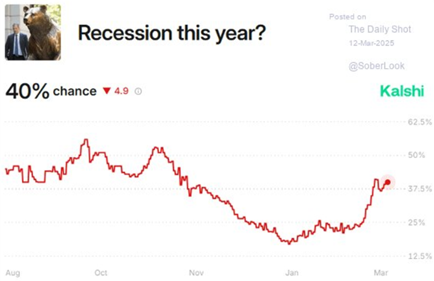
Source: https://kalshi.com/markets/kxrecssnber/recession
“Tariffied” Analysts
Analysts have trimmed their profit expectations for the S&P 500 by 3-4% in recognition of tariff impacts. Remember that someone must pay the tariff. The exporter, the importer, the retailer, and the consumer will all share the burden. Goods that are more commoditized place more burden on the seller, while goods that are specialized will place more burden on the buyer. As Ronald Reagan quipped, “If you want less of something, tax it.” Tariffs tax commerce. Less commerce cleanly translates into less corporate earnings:
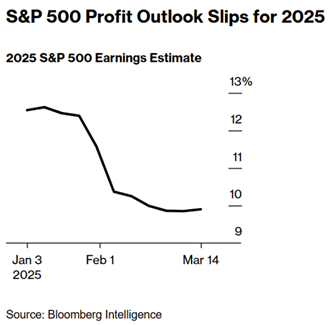
Source: https://www.bloomberg.com/news/articles/2025-03-15
“Tariffied” Central Bankers
The Fed may have left interest rates unchanged at their meeting last week, but they did not leave forecasts unchanged. In their summary of economic projections, they increased inflation expectations while decreasing their growth expectations. Economists call this indicator conflict… stagflation:
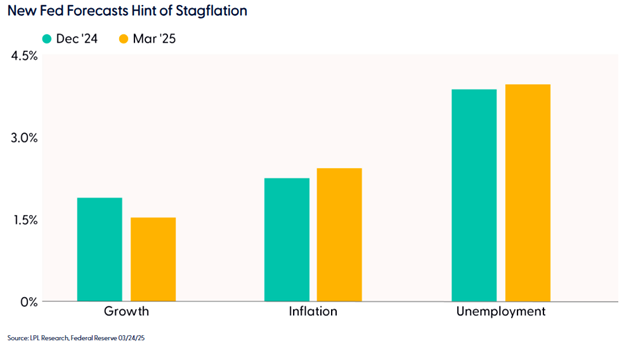
Source: https://www.lpl.com/research/weekly-market-commentary/powell-walked-a-tightrope.html
Liberation Day!
Trump will reveal his tariff strategy on April 2nd, a day he now refers to as “Liberation Day”. While no one knows exactly what Trump will say, three potential strategies hold contention. First, tariffs could be used to plug the deficit hole. If DOGE can cut a trillion, and a 25% tariff on all imports can provide a trillion in revenues, voila, the budget balances! Second, the tariffs could be used to re-industrialize the United States of America. US-based manufacturing currently represents 10% of US GDP, compared to 25% in the 1970s and 27.5% in China today. Wouldn’t it be great if we made all our own cars again? Third, the tariffs could be used to bully the “Dirty Fifteen” into lowering their tariffs on American-made goods. Trump cited the offenders listed below:

Source: https://www.wsj.com/economy/trade/us-trade-import-export-deficit-charts-490a7bce
Each of these nations tariffs US imports at some level. Further opening these markets to US exporters would help improve the trade deficit, increase US manufacturing, and support GDP growth.
Most likely, the tariffs simply become a tool of statecraft and rather than apply blindly to all our trade partners, they will be used to extract concessions like border security, defense spending, US import commitments, currency adjustments, and tax reforms. But, if Trump speaks more about using tariffs to reduce or eliminate tariffs with trading partners (already in the works with India), this pessimistic and oversold market will surge.
I leave you with one more chart that details forward returns for the S&P 500 following previous sharp, sentiment-driven corrections. Remember, Trump prefers to be loved… and Trump would also prefer to win the mid-term elections. While few expect it, and the market is positioned against it, Trump may just use “Liberation Day” to liberate the bulls!
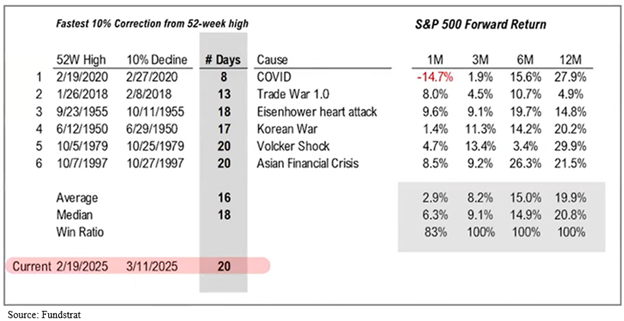
Source: fsinsight.com
Have a great weekend!
Related: Trump's 'Liberation Day': Markets Brace for Economic Chaos on April 2nd
Sources: FS Insight, Bloomberg LP, Conference Board, Census Department, LPL Research, Kalshi, Isabelnet, Advisor Perspectives


